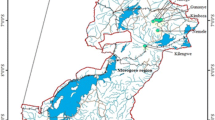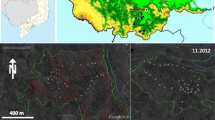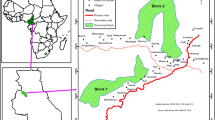Abstract
This paper provides a botanical inventory of a forest community in the North Negros Forest Reserve that is disproportionately valuable from a conservation perspective. The forest fragment is one of the last remaining wet tropical rainforest ecosystems in the biogeographic region of the West Visayas and an important refuge for a large number of endemic species. Using standard methods of the Philippine Plant Inventory Project we described the structure and composition of this little known forest type in the transition zone between lowland and lower montane forest. A 1 ha inventory plot 500 × 20 m in size was established and all trees of 10 cm DBH or greater were measured and permanently labeled. Subsequently, fertile specimens were collected over a period of 18 months. We found 645 individuals belonging to 92 species, 54 genera and 39 families with a combined basal area of 58.8 m2 and an average canopy height of 30 m. This community was not dominated by dipterocarps. Species of Lauraceae, Burseraceae, Sapotaceae and Icainaceae were equally or more important. Diversity measured as Shannon–Wiener index (5.59), equitability index (0.86) and Simpson index (0.032) was high, and no single family or species dominated the plot.
Similar content being viewed by others
References
Ashton PS (1993) Philippine phytogeography. Asia Life Science 2: 1–8
Bongers F, Popma J, del Castillo JM and Carabias J (1988) Structure and floristic composition of the lowland rainforest of Los Tuxlas, Mexico. Vegetatio 74: 55–80
Brown WH (1919) Vegetation of the Philippine Mountains: the Relation between the Environment and Physical Types at Different Altitudes. Dept. of Agriculture and Natural Resources Publication No 13. Bureau of Science Publications, Manila
Curio E, Hamann A, Heubüschl P and Lastimoza L (1996) Hornbill research and conservation in the Philippines. EEP Hornbill TAG Newsletter 2: 26–27
Davis SD (1995) Identifying sites of global importance for conservation: The IUCN/WWF centers of plant diversity project. In: Primack RB and Lovejoy TE(eds) Ecology, Conservation and Management of Southeast Asian Rainforests, pp 176–203. Yale University Press, New Haven, CT
Dinerstein E, Wikramanayake ED and Forney M (1995) Conserving the reservoirs and remnants of tropical moist forest in the Indo-Pacific region. In: Primack RB and Lovejoy TE (eds) Ecology, Conservation and Management of Southeast Asian Rainforests, pp 140–175. Yale University Press, New Haven, CT
Hamann A and Curio E (1999) Interactions among frugivores and fleshy fruit trees in a Philippine submontane rainforest. Conservation Biology (in press)
Heaney L (1993) Biodiversity patterns and the conservation of mammals in the Philippines. Asia Life Science 2: 261–274
Hill MO (1973) Diversity and Evenness: a unifying notation and its consequences. Ecology 54: 427–432
Howe HF (1986) Seed dispersal by fruit-eating birds and mammals. In: David R (ed) Seed Dispersal, pp 123–189. Academic Press, London
Kartawinata K (1989) A review of natural vegetation studies in Malesia with special reference to Indonesia. In: Baas P (ed) The Plant Diversity of Malesiana, pp 121–132. Kluwer Academic Publishers, Dordrecht, The Netherlands
Kartawinata K, Abdulhadi R and Partomohardjo T (1981) Composition and structure of a lowland dipterocarp forest at Wanariset, East Kalimantan. Malayan Forester 44: 397–496
Madulid DA (1996) Permanent forest and non-forest inventory plot protocol. Philippine Flora Newsletter 9: 2
Merlin MD and Juvik JO (1994) Montane cloud forests in the tropical Pacific: some aspects of their floristics, biogeography, ecology, and conservation. In: Hamilton LS, Juvik JO and Scatena FN (eds) Tropical Montane Cloud Forests, pp 234–253. Ecological Studies, Vol 110. Springer-Verlag, New York
Newbery DMcC, Campbell EJF, Lee YF, Ridsdale CE and Still MJ (1992) Primary lowland dipterocarp forest at Danum Valley, Sabah, Malaysia: structure, relative abundance and family composition. In: Marshall AG and Swaine MD (eds) Tropical Rain Forest: Disturbance and Recovery, pp 341–356. Alden Press, Oxford
Oliver WLR (1993) Threatened endemic artiodactyls of the Philippines: status and future priorities. International Zoo Yearbook 32: 132–144
Penafiel SR (1980) The mossy forests of the Central Cordillera Ranges in the Philippines. Canopy International 6: 6–7
Penafiel SR (1994) The biological and hydrological values of the mossy forests in the Central Cordillera Mountains, Philippines. In: Hamilton LS, Juvik JO and Scatena FN (eds) Tropical Montane Cloud Forests, pp 266–273. Ecological Studies, Vol. 110. Springer-Verlag, New York
Pipoly JJ and Madulid DA (1998) Composition, structure and diversity of a Philippine submontane moist forest in Mt. Kinasalapi, Kitanglad range, Mindanao, In: Dallmeier F and Comiskey JA (eds) Forest Biodiversity Research, Monitoring and Modeling, pp 591–600. Parthenon Publishing Group, Paris
Proctor J, Anderson JM, Chai P and Vallack HW (1983) Ecological studies in four contrasting lowland rain forests in Gunung Mulu National Park, Sarawak. I. Forest environment, structure and floristics. Journal of Ecology 71: 237–260
Richards PW (1982) The three dimensional structure of tropical rain forests. In: Sutton SL, Whitmore TC and Chadwick AC (eds) Tropical Rainforest: Ecology and Management, pp 3–10. Blackwell Scientific Publications, Oxford
Soepadmo E (1995) Plant diversity of the Malaysian tropical rainforest and its phytogeographical and economic significance. In: Primack RB and Lovejoy TE (eds) Ecology, Conservation and Management of Southeast Asian Rainforests, pp 19–40. Yale University Press, New Haven, CT
Van der Pijl L (1982) Principles of Dispersal in Higher Plants. Springer-Verlag, Berlin
Whitmore TC (1984) Tropical Rainforests of the Far East. Clarendon Press, Oxford
Whitmore TC (1995) Comparing Southeast Asian and other tropical rainforests. In: Primack RB and Lovejoy E (eds) Ecology, Conservation and Management of Southeast Asian Rainforests, pp 5–15. Yale University Press, New Haven, CT
Author information
Authors and Affiliations
Rights and permissions
About this article
Cite this article
Hamann, A., Barbon, E., Curio, E. et al. A botanical inventory of a submontane tropical rainforest on Negros Island, Philippines. Biodiversity and Conservation 8, 1017–1031 (1999). https://doi.org/10.1023/A:1008847704539
Issue Date:
DOI: https://doi.org/10.1023/A:1008847704539




